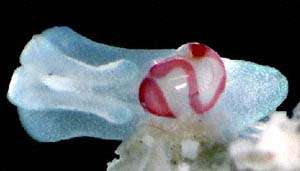Recognize this youngster
March 12, 1998
From: Clay Carlson

Bill,
Recognize this youngster?
We think we know what it is but put it back rather than try to raise it. The specimen is 2.5mm long. It came from Toguon Bay, Guam, 7m depth. Our guess at this time is that it represents a juvenile Micromelo undata. There is a touch of blue-green showing up on the margin of the tail and I saw a number of adults in the back yard (Bile Bay) a month earlier. [Note: Bile Bay is in the village of Merizo in the southern part of Guam.] Toguon Bay is about 1/2 k north of us. North of that is Umatac Bay--visited 17 March 1819 by the Uranie which just happened to be carrying Quoy & Gaimard. They described Micromelo guamensis from the island. Recently the name has been synonymized with M. undata.
We have no idea what the purpose would be of the red on the juvenile form. While in the Philippines last year a large number of young Atys naucum were found --all with red banded shells that became less noticeable as the size of the animal increased. It would be interesting to know how wide spread the 'juvenile red' phenomena is.
Clay Carlson
Merizo, Guam
clay.carlson@saba.kuentos.guam.ne
Carlson, C. & Hoff, P.J., 1998 (Mar 12) Recognize this youngster. [Message in] Sea Slug Forum. Australian Museum, Sydney. Available from http://www.seaslugforum.net/find/79It reminds me of another bubble-shell, Hydatina amplustre, which has pink bands on its shell, but the shape of the animal certainly looks like Micromelo. If you have a look at the tip of the spire of many marine snails you will see the protoconch or larval shell. This is the shell that protected the larval snail or early juvenile animal. It is often pinkish or red but why this is so I have no idea. You mention that the name of this animal has been replaced by Micromelo undata, which is the name given to a species found in the Caribbean and the Atlantic Coast of South America. Perhaps I am being too conservative, but I would like to see a bit more evidence to support the idea that they are indeed one species.
For those who wonder why we have shelled snails in a Slug Forum, let me explain. Sea Slugs are essentially marine snails which have lost their shells during their evolution. The "Bubble Shells" are a group of primitive opisthobranchs which illustrate various stages in the loss of the shell. The Bubble Shells (Order Cephalaspidea) include many unrelated families. The Hydatinidae have thinly calcified shells and large colourful bodies. They all feed on cirratulinid worms ...Bill Rudman
Rudman, W.B., 1998 (Mar 12). Comment on Recognize this youngster by Clay Carlson. [Message in] Sea Slug Forum. Australian Museum, Sydney. Available from http://www.seaslugforum.net/find/79Related messages
-
Micromelo undata from the Andaman Islands
From: C.R. Sreeraj, February 17, 2010 -
Micromelo undata found sthn Queensland
From: Gary Cobb, January 19, 2009 -
Re: Micromelo undata - developing veligers
From: Philibert Bidgrain, November 20, 2006 -
Micromelo undata - developing veligers
From: Philibert Bidgrain, November 16, 2006 -
Collective spawning in Micromelo undata
From: Philibert Bidgrain, November 16, 2006 -
Micromelo undata from the Canary Islands
From: Christian Kowalewski, August 19, 2006 -
Micromelo undata from Bali
From: Erwin Kodiat, April 20, 2006 -
Micromelo undata from South Africa
From: Colin Ogden, August 20, 2005 -
Micromelo undata from northeastern Brazil
From: Vinicius Padula, February 15, 2005 -
Micromelo undata with own garden
From: Valda Fraser, January 31, 2003 -
Micromelo undata from New South Wales, Australia
From: John Pogonoski, August 14, 2002 -
Micromelo undata from Christmas Island
From: W.B. Rudman, May 3, 2002 -
Micromelo undata from Florida
From: Linda Ianniello, January 31, 2002 -
Micromelo undata? - undatus? - more grammar
From: Erwin Koehler, February 18, 1999 -
Re: Recognize this youngster
From: Dr Richard Willan, May 22, 1998 -
Re: Recognize this youngster
From: Bernard Picton, March 26, 1998
